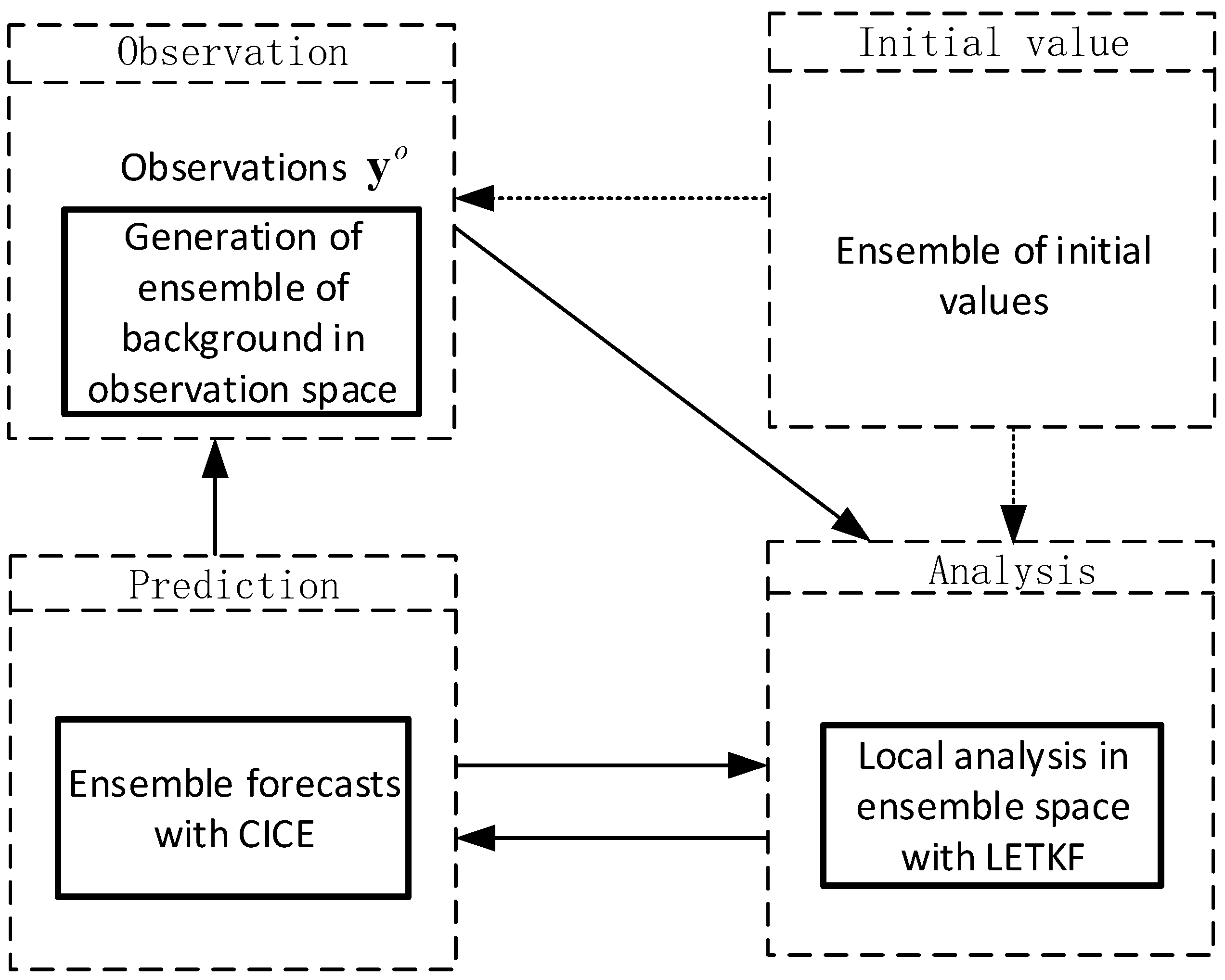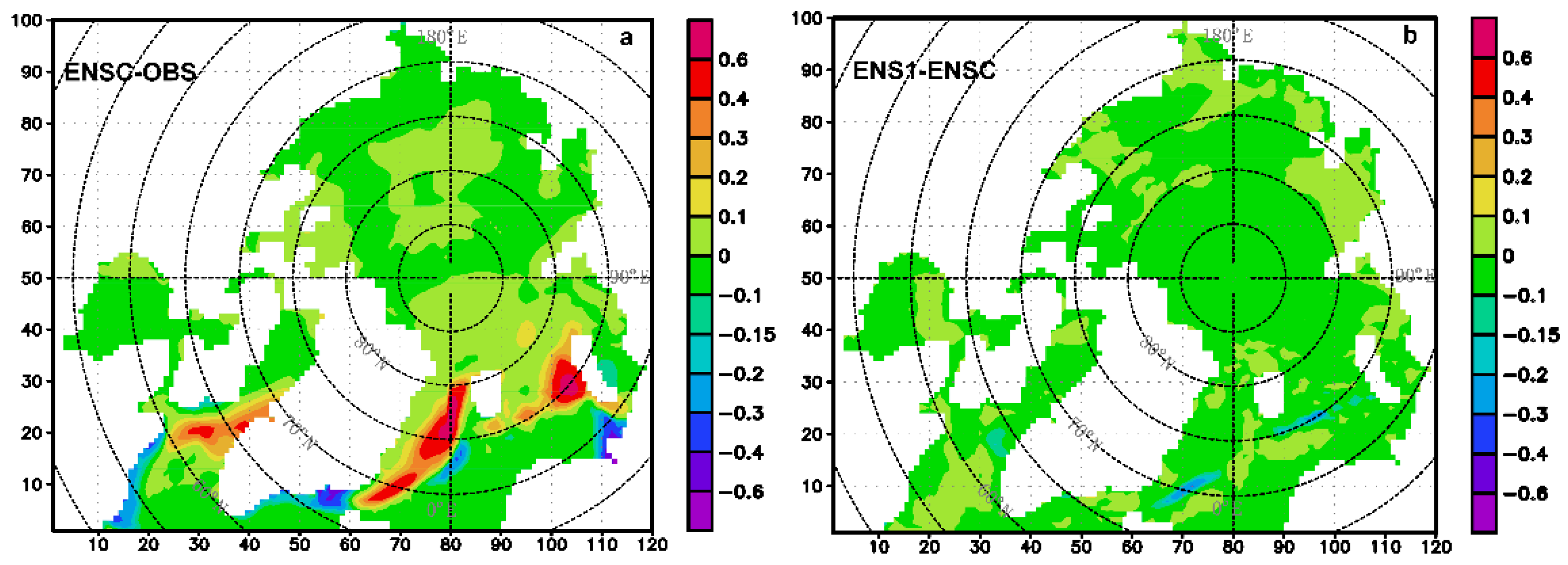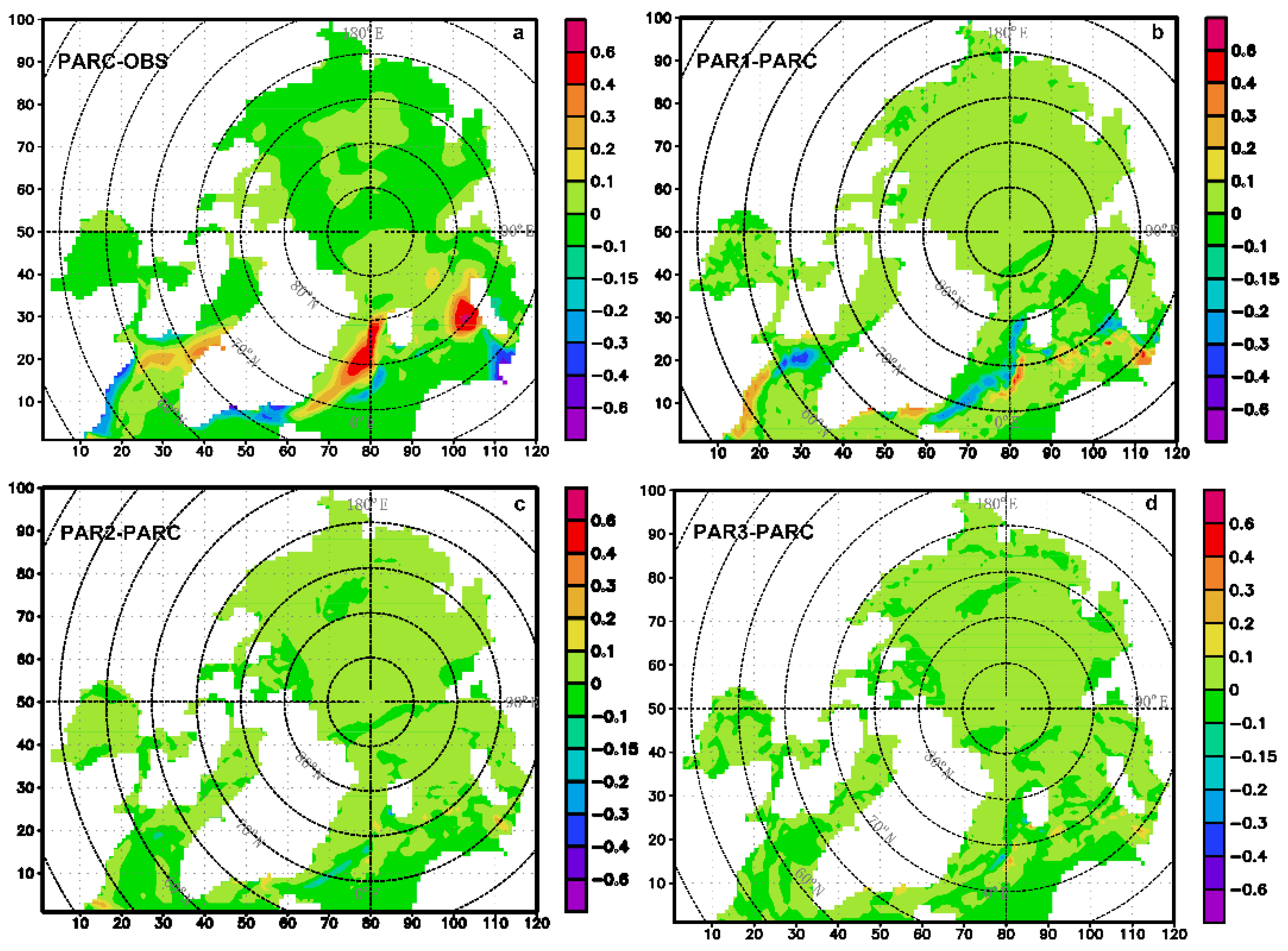CICE-LETKF Ensemble Analysis System with Application to Arctic Sea Ice Initialization
Abstract
1. Introduction
2. Methods and Data
2.1. Ensemble Analysis System
2.2. Data
3. Theory and Calculation
3.1. Theory
3.2. Calculation
4. Results and Discussion
5. Conclusions
Author Contributions
Funding
Institutional Review Board Statement
Informed Consent Statement
Data Availability Statement
Acknowledgments
Conflicts of Interest
Appendix A

References
- Liu, X.Y.; Liu, H.L.; Li, W.; Zhang, X.H.; Yu, R.C.; Yu, Y.Q. Numerical simulation of atmosphere-ocean-sea ice interaction during the interannual cycle in high northern latitudes. Acta Meteorol. Sin. 2008, 22, 119–128. [Google Scholar]
- Shepherd, T.G.; Arblaster, J.M.; Bitz, C.M.; Furevik, T.; Goosse, H.; Kattsov, V.M.; Marshall, J.; Ryabinin, V.; Walsh, J.E. Report on WCRP workshop on seasonal to multi-decadal predictability of polar climate. SPARC Newsl. 2011, 36, 11–19. [Google Scholar]
- Liu, X.; Zhang, L. Study on optimization of sea ice concentration with adjoint method. J. Coast. Res. 2018, 84, 44–50. [Google Scholar] [CrossRef]
- Zhang, Y.F.; Bitz, C.M.; Anderson, J.L.; Collins, N.; Hendricks, J.; Hoar, T.; Raeder, K.; Massonnet, F. Insights on sea ice data assimilation from perfect model observing system simulation experiments. J. Clim. 2018, 31, 5911–5926. [Google Scholar] [CrossRef]
- Meier, W.N.; Maslanik, J.A.; Fowler, C.W. Error analysis and assimilation of remotely sensed ice motion within an Arctic sea ice model. J. Geophys. Res. 2000, 105, 3339–3356. [Google Scholar] [CrossRef]
- Zhang, J.; Thomas, D.R.; Rothrock, D.A.; Lindsay, R.W.; Yu, Y.; Kwok, R. Assimilation of ice motion observations and comparisons with submarine ice thickness data. J. Geophys. Res. 2003, 108, 3170. [Google Scholar] [CrossRef]
- Tietsche, S.; Notz, D.; Jungclaus, J.H.; Marotzke, J. Assimilation of sea-ice concentration in a global climate model—Physical and statistical aspects. Ocean Sci. 2013, 92, 19–36. [Google Scholar] [CrossRef]
- Yang, Q.; Losa, S.N.; Losch, M.; Tian-Kunze, X.; Nerger, L.; Liu, J.; Kaleschke, L.; Zhang, Z. Assimilating SMOS sea ice thickness into a coupled ice-ocean model using a local SEIK filter. J. Geophys. Res. Oceans 2014, 119, 6680–6692. [Google Scholar] [CrossRef]
- Nerger, L.; Danilov, S.; Hiller, W.; Schröter, J. Using sea-level data to constrain a finite-element primitive-equation ocean model with a local SEIK filter. Ocean Dyn. 2006, 56, 634–649. [Google Scholar] [CrossRef]
- Toyoda, T.; Fujii, Y.; Yasuda, T.; Usui, N.; Ogawa, K.; Kuragano, T.; Tsujino, H.; Kamachi, M. Data assimilation of sea ice concentration into a global ocean—Sea ice model with corrections for atmospheric forcing and ocean temperature fields. J. Oceanogr. 2016, 72, 235–262. [Google Scholar] [CrossRef]
- Evensen, G. Sequential data assimilation with a nonlinear quasigeostrophic model using Monte-Carlo methods to forecast error statistics. J. Geophys. Res. 1994, 99, 10143–10162. [Google Scholar] [CrossRef]
- Miyoshi, T.; Yamane, S. Local ensemble transform Kalman filtering with an AGCM at a T159/L48 resolution. Mon. Weather Rev. 2007, 135, 3841–3861. [Google Scholar] [CrossRef]
- Sakov, P.; Counillon, F.; Bertino, L.; Lisæter, K.A.; Oke, P.R.; Korablev, A. TOPAZ4: An ocean-sea ice data assimilation system for the North Atlantic and Arctic. Ocean Sci. 2012, 8, 633–656. [Google Scholar] [CrossRef]
- Hunt, B.R.; Kostelich, E.J.; Szunyogh, I. Efficient data assimilation for spatiotemporal chaos: A local ensemble trans-form Kalman filter. Phys. D 2007, 230, 112–126. [Google Scholar] [CrossRef]
- Bishop, C.H.; Etherton, B.; Majumdar, S.J. Adaptive sampling with the ensemble transform Kalman fifilter part I: The theoretical aspects. Mon. Weather Rev. 2001, 129, 420–436. [Google Scholar] [CrossRef]
- Houtekamer, P.L.; Mitchell, H.L. Data assimilation using an ensemble Kalman filter technique. Mon. Weather Rev. 1998, 126, 796–811. [Google Scholar] [CrossRef]
- Shin, S.; Kang, J.S.; Jo, Y. The Local Ensemble Transform Kalman Filter (LETKF) with a Global NWP Model on the Cubed Sphere. Pure Appl. Geophys. 2016, 173, 2555–2570. [Google Scholar] [CrossRef]
- Anderson, J.L.; Anderson, S.L. A Monte Carlo implementation of the nonlinear filtering problem to produce ensemble assimilations and forecasts. Mon. Weather Rev. 1999, 127, 2741–2758. [Google Scholar] [CrossRef]
- Houtekamer, P.L.; Mitchell, H.L.; Pellerin, G.; Buehner, M.; Charron, M.; Spacek, L.; Hansen, B. Atmospheric Data Assimilation with an Ensemble Kalman Filter: Results with Real Observations. Mon. Weather Rev. 2005, 133, 604–620. [Google Scholar] [CrossRef]
- Hamill, T.M.; Whitaker, J.S. Accounting for the error due to unresolved scales in ensemble data assimilation: A comparison of different approaches. Mon. Weather Rev. 2005, 133, 3132–3147. [Google Scholar] [CrossRef]
- Whitaker, J.S.; Hamill, T.M.; Wei, X.; Song, Y.; Toth, Z. Ensemble data assimilation with the NCEP global forecast system. Mon. Weather Rev. 2008, 136, 463–482. [Google Scholar] [CrossRef]
- Zhang, F.; Snyder, C.; Sun, J. Impacts of initial estimate and observation availability on convective-scale data assimilation with an ensemble Kalman filter. Mon. Weather Rev. 2004, 132, 1238–1253. [Google Scholar] [CrossRef]
- Buizza, R.; Miller, M.; Palmer, T.N. Stochastic representation of model uncertainties in the ECMWF Ensemble Prediction System. Q. J. R. Meteorol. Soc. 1999, 125, 2887–2908. [Google Scholar] [CrossRef]
- Shutts, G.J. A kinetic energy backscatter algorithm for use in ensemble prediction systems. Q. J. R. Meteorol. Soc. 2005, 131, 3079–3102. [Google Scholar] [CrossRef]
- Bonavita, M.; Torrisi, L.; Marcucci, F. Ensemble data assimilation with the CNMCA regional forecasting system. Q. J. R. Meteorol. Soc. 2010, 136, 132–145. [Google Scholar] [CrossRef]
- Hunke, E.; Allard, R.; Bailey, D.A.; Blain, P.; Bouchat, A.; Craig, T.; Winton, M. CICE-Consortium/CICE: CICE Version 6.0.2 (CICE6.0.2). Zenodo 2019. Available online: https://zenodo.org/record/3516944#.YR7_m98RVPY (accessed on 16 October 2019).
- Uppala, S.; Dee, D.; Kobayashi, S.; Berrisford, P.; Simmons, A. Towards a climate data assimilation system: Status update of ERA-interim. ECMWF Newsl. 2008, 115, 12–18. [Google Scholar]
- Locarnini, R.A.; Mishonov, A.V.; Antonov, J.I.; Boyer, T.P.; Garcia, H.E.; Baranova, O.K.; Zweng, M.M.; Johnson, D.R. World Ocean Atlas 2009, Volume 1: Temperature. In NOAA Atlas NESDIS 68; Levitus, S., Ed.; U.S. Government Printing Office: Washington, DC, USA, 2010. [Google Scholar]
- Antonov, J.I.; Seidov, D.; Boyer, T.P.; Locarnini, R.A.; Mishonov, A.V.; Garcia, H.E.; Baranova, O.K.; Hatfield, S.; Subramanian, A.; Palmer, T.; et al. Improving Weather Forecast Skill through Reduced-Precision Data Assimilation. Mon. Weather Rev. 2017, 146, 49–62. [Google Scholar]
- Cavalieri, D.J.; Parkinson, C.L.; Gloersen, P.; Zwally, H.J. Sea Ice Concentrations from Nimbus-7 SMMR and DMSP SSM/I-SSMIS Passive Microwave Data, Version 1; NSIDC-0051; NSIDC: Boulder, CO, USA, 1996; Available online: https://nsidc.org/data/NSIDC-0051/versions/1 (accessed on 28 July 2018).
- Yang, Q.; Losa, S.N.; Losch, M.; Jung, T.; Nerger, L. The role of atmospheric uncertainty in Arctic summer sea ice data assimilation and prediction. Q. J. R. Meteorol. Soc. 2015, 141, 2314–2323. [Google Scholar] [CrossRef]
- Yang, Q.; Losch, M.; Losa, S.N.; Jung, T.; Nerger, L. Taking into account atmospheric uncertainty improves sequential assimilation of SMOS sea ice thickness data in an ice—Ocean model. J. Atmos. Ocean. Technol. 2016, 33, 397–407. [Google Scholar] [CrossRef][Green Version]




| Name | Description |
|---|---|
| OBSC | Ensemble size was 20; the initial values for the ensemble prediction were randomly taken from the restart field of control run without DA every 7 days; no observation was assimilated in the ensemble simulation. |
| OBS1 | Same as OBSC except the SIC adopted every 4 grids from the observation field was assimilated. |
| OBS2 | Same as OBSC except the SIC adopted every 2 grids from the observation field was assimilated. |
| Name | Description |
|---|---|
| ENSC | Ensemble size was 20; the initial values for the ensemble prediction were randomly taken from the restart field of control run without DA every 3 days; the SIC was adopted every 4 grids from the observation field. |
| ENS1 | Same as ENSC except that ensemble size was 40. |
| Name | Description |
|---|---|
| INIC | Ensemble size was 20; the initial values for the ensemble prediction were randomly taken from the restart field of control run without DA every 7 days; the SIC was adopted every 4 grids from the observation field. It was identical to OBS1 in Table 1. |
| INI1 | Same as INIC except that the initial values for the ensemble prediction were randomly taken from the restart field of control run without DA every 3 days. It was identical to ENSC in Table 2. |
| Name | Description |
|---|---|
| PARC | Ensemble size was 20; the initial values for the ensemble prediction were randomly taken from the restart field of control run without DA every 7 days; the SIC adopted every 4 grids from the observation field was assimilated. It was identical to OBS1 in Table 1. |
| PAR1 | Same as PARC except that covariance inflation was performed in the filtering with = 2 in Equation (12). |
| PAR2 | Same as PARC except that perturbation relaxation was performed in the filtering with = 0.5 in Equation (13). |
| PAR3 | Same as PARC except that spread relaxation was performed in the filtering with = 0.5 in Equation (14). |
Publisher’s Note: MDPI stays neutral with regard to jurisdictional claims in published maps and institutional affiliations. |
© 2021 by the authors. Licensee MDPI, Basel, Switzerland. This article is an open access article distributed under the terms and conditions of the Creative Commons Attribution (CC BY) license (https://creativecommons.org/licenses/by/4.0/).
Share and Cite
Liu, X.; Sha, Z.; Lu, C. CICE-LETKF Ensemble Analysis System with Application to Arctic Sea Ice Initialization. J. Mar. Sci. Eng. 2021, 9, 920. https://doi.org/10.3390/jmse9090920
Liu X, Sha Z, Lu C. CICE-LETKF Ensemble Analysis System with Application to Arctic Sea Ice Initialization. Journal of Marine Science and Engineering. 2021; 9(9):920. https://doi.org/10.3390/jmse9090920
Chicago/Turabian StyleLiu, Xiying, Zicheng Sha, and Chenchen Lu. 2021. "CICE-LETKF Ensemble Analysis System with Application to Arctic Sea Ice Initialization" Journal of Marine Science and Engineering 9, no. 9: 920. https://doi.org/10.3390/jmse9090920
APA StyleLiu, X., Sha, Z., & Lu, C. (2021). CICE-LETKF Ensemble Analysis System with Application to Arctic Sea Ice Initialization. Journal of Marine Science and Engineering, 9(9), 920. https://doi.org/10.3390/jmse9090920






